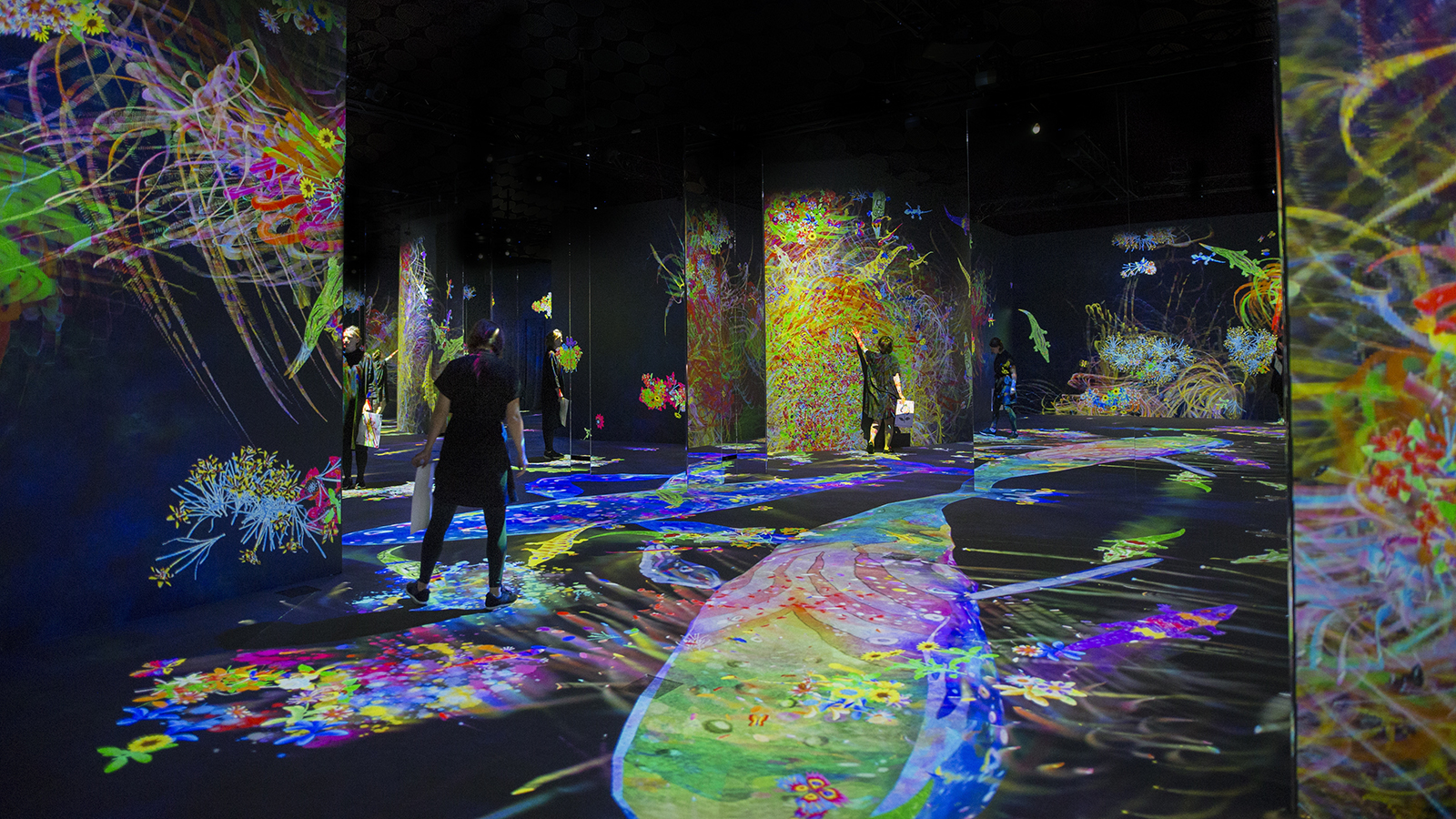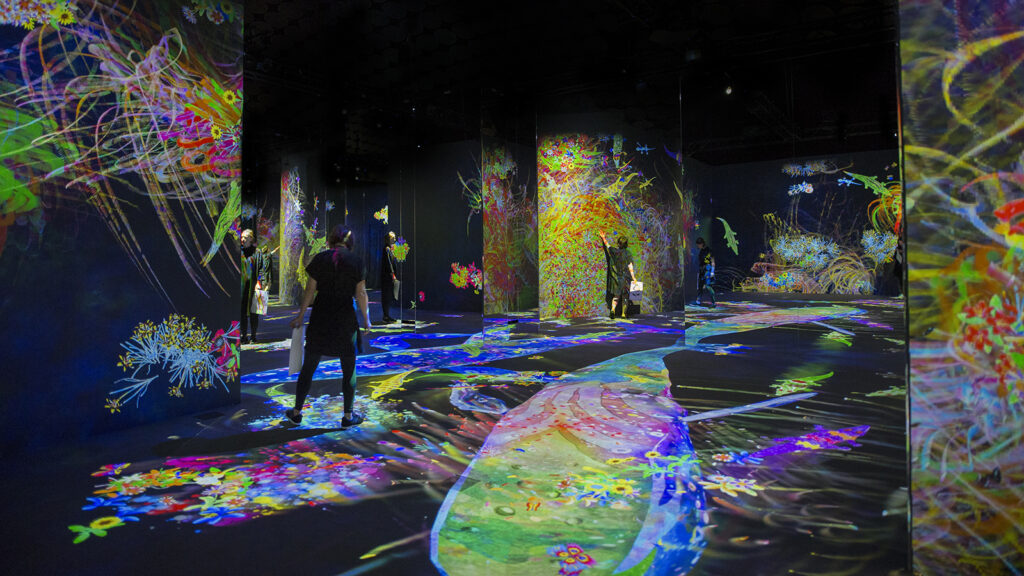
Filter by Columns


While modern art can exist to challenge the viewer, it can also fail to engage or draw the viewer in. Immersive art presents an opportunity for a different experience, where art combined with technology can engage the viewer’s curiosity and inspire playfulness. A well-designed exhibit can almost guarantee a powerful, direct experience without the need for theoretical background.
Walking through an art gallery, I enter another spacious, well-lit room and look around. A large painting on the left catches my attention, and I walk up to it.
This artwork doesn’t exist, nor does the gallery. It’s just an exaggerated stereotype based on several poorly remembered past experiences. I can hardly comment authoritatively on the art that evoked those experiences, since I didn’t actually absorb what I was seeing.
But that’s all right, because that’s the whole point.
So, I stop in front of this painting. I look at it. I don’t get it. It seems pointless to me. I wonder whether it actually took skill to create. Knowing there are all kinds of different ways of having and communicating meaning, I scrutinize it in search of understanding. I read the tag beside it to see the name of the piece. There’s also a short description there that gives me a hasty idea of how I’m apparently supposed to interpret it and react to it. I look at the art again in that light, and think it makes a little sense now—maybe.
Then I move on, feeling that I’ve failed to connect with the piece or understand it.
What else did the experience do? My having to pause to wonder at what I’m seeing might have caused me to broaden my view of just what is art—except that we all already know modern art is weird and tests the boundaries of art. It’s almost a stereotype that viewers find it incomprehensible.
This is no indictment of modern art. However, to the extent that art fails to actually engage and draw in an unschooled viewer, there is something missing from its public display.
*
Now, picture this instead. In an exhibit of modern art, I enter a dimly lit room, a confusing space with angles and turns, where virtual creatures made of light—animated animal shapes projected from near the ceiling—soar and crawl along the walls.
No need to stop and stare and try to understand or try to achieve whatever experience the tag attempts to teach me. All I need to do is enter, led by natural curiosity. In fact, there are even children wantonly milling around the exhibit, and no wonder.
Immersive art installations where the piece of art dominates the space in the room, or even defines the room so that the audience enters inside the art, and becomes one with it, have become common in recent years. They also circulate internationally and online, so I have been able to access them without leaving Finland.
The archetypical immersive exhibit to me remains the inaugural exhibition of the Amos Rex gallery in Helsinki from 2018 to 2019, “Massless” by teamLab. The space with creatures of light projected on the wall that I mentioned above was “Graffiti Nature: Lost, Immersed and Reborn”. It felt like a forest, though not made up of trees, but moving creatures such as butterflies, whales projected onto the walls, ceiling and floor. Plants sprout on the walls when you touch them. The animals also interact with you and each other, except for the whales in their majestic, untouchable background hugeness. Bigger animals eat smaller ones, and they will go splat if you touch or stomp on them enough—allowing both children and adults to test out their mischief without doing any actual harm.
The gallery is reminiscent of a virtual world where you interact with the elements around you. Admittedly, the illusion is easily disturbed when the system misreads your position slightly, highlighting how the patterns on the surfaces are not really things you’re interacting with directly.
Further, the creatures are colourfully designed—drawn by crayon on paper by visitors, scanned, and incorporated into the program.

*
“Vortex of Light Particles” is the next installation I entered—it is more simple and contemplative, and highly immersive. Set in a round, dark room with a concave ceiling, it was exactly as its name describes: a vortex of light flowing endlessly towards a black hole in the center, accompanied by an unearthly, musical hum, inviting people to lie down on the floor and contemplate the exquisite phenomenon before them.
“Crows Are Chased the Chasing Crows Are Destined to Be Chased as Well, Transcending Space,” whose confusing title is in fact intentional and descriptive, was not free for viewers to enter and leave at any time like the other rooms, but instead, they had to cue for a “show”, which consists of images of light projected onto the planes of the room as before. When the show begins, virtual birds chase each other around in space at a bewildering speed, tracing trails of light. The visitor’s point of view continually shifts along with the birds, as if the room itself is moving—if you still acknowledge its existence as the walls open into infinity.
One stereotype of modern art is that “my six-year-old could have done that,” when the artwork is making a point that is obscure to the viewer and seems to have required no impressive skills to create. The logic of immersive installation tends towards the complete opposite: you can enjoy this too, because even your six-year-old could.
What kind of art exhibit or installation would entice a child? Presumably, something that evokes their curiosity and gives them something to do. And, frankly, adults don’t play enough, and are often unknowingly on the lookout for an excuse to do so in a socially acceptable way. Being in an art exhibit, and not one that’s too serious and dry but one that’s acknowledged to be potentially weird, as modern art is, is such an excuse.
This may be turning art into entertainment, but is it supposed to be unentertaining in order to have artistic merit? It’s also important for art to engage the audience. The anti-immersive “What the heck is this supposed to be?” or “Why is this called art?” is one type of experience you could get, but it’s already been done.
Perhaps any time you truly engage with a piece of art, directly and un-analytically, is an instance of play. Of course, adults are capable of more patient absorption than children. While the “Graffiti Nature” could almost have been planned for children specifically, “Vortex of Light Particles” rewarded its participants with a more passive, contemplative absorption.
But does it take advanced technology to make an immersive art exhibit or installation? Though it’s true that exhibits enabled through technology have become common, the new phenomenon as I see it consists of installations and other artworks at all technological levels. What they have in common is the immersion itself.
Sometimes, an artwork requires technology—but not always complex technology. “Phantom Train” by Daniel Crooks—which I saw in Wäinö Aaltonen Museum in Turku in an exhibit on temporality that ran from 2019 to 2020—only requires two screens with projected images that the viewer sits or stands between. On one side, you see what’s “behind” you receding into the distance, and on the other, what’s “ahead” of you, coming closer. The imagery is a composite video of train tracks, along which your perspective travels, only the tracks lead from one scene to another, always passing into what seems like a mirror or a window and then suddenly becomes your surroundings. The artist was apparently trying to reflect on time and on four-dimensional existence—high-flying concepts that the viewer nevertheless gets automatically absorbed into. Of course, the appearance of technological simplicity can be deceiving. Still, it doesn’t take expensive and complicated technology to make an exhibit immersive. Imagine a large room filled with thick lianas and wall hangings made up of synthetic wigs in different garish colors. In “Nervescape VIII” by Hrafnhildur Arnardóttir or “Shoplifter”, displayed in Kiasma in Helsinki in 2019, you are allowed to touch this exhibit. As the artist points out, this is a form of readymade art because it uses existing wigs. However, in my view, that doesn’t matter as much as what is done with them—and how this affects the audience.
In EMMA, the Espoo Museum of Modern Art, I visited, among other things, a large room filled with a labyrinth made up of walls of different materials (Daniel Buren: “Going for a Walk in a Zigzag”), and another, smaller labyrinth made up of crisscrossing red strings (“Tracing Boundaries” by Chiharu Shiota), where I was fascinated by the ever-shifting patterns made up by the myriad lines making up the translucent walls crisscrossing from different angles. While these and other interesting and immersive works were not high-tech, their power to make art interactive was shown in a smaller piece (untitled, by Aparna Rao and Søren Rao aka Pors & Rao). It might look at first like a simple square on the wall—but if you wait in silence, more and more simple little “faces” cautiously peer from behind the edges, only to vanish again in an instant when you make noise. Naturally, this is another example that encourages adult playfulness. And if you were to just stare at this seemingly pointless blank canvas in an effort to discern its meaning, you would be rewarded, with an experience if not meaning.
*
The essence of this phenomenon isn’t really technology itself, especially new technology. Every installation involves some kind of technology in building it, and I have little doubt that many complicated artworks constructed of crude matter rather than electricity or light actually do involve modern technologies in their creation. However, as far as immersion and childlike fascination go, what’s essential is for the artwork to project something to the viewer that catches their attention and rewards their effort to be present even without an advanced degree in art history: when the viewer can enter an installation, interact with it, have it react to them in return.
High-tech solutions are just one way to create these effects. Then again, they may be the future of immersive art. The exhibits I have seen so far are still relatively crude in their use of advanced technology, and even so, they were among the more effective immersive experiences. A moving, even emergent artscape offers much novelty to captivate the viewer, and it’s hard to offer much concrete viewer interaction without at least some technology. “Graffiti Nature” even as a slightly less elegant virtual reality experience offers possibilities, though imperfect, that would have seemed impossible some time ago: being able to interact with creatures projected on the wall, as if they were real. Sometimes technology or interactivity in the arts can seem a little gratuitous. At the same time, it offers more possibilities. What will come next? The only limit is the artist’ imagination—fortunately, an unlimited resource.

Ville V. Kokko is a Ph.D. student in Philosophy at the University of Turku, living in Turku, Finland. While writing his dissertation, he’s also slowly working on becoming a fiction writer, nonfiction author, some kind of reporter, and maybe even a comic artist. He’s not an expert on art, but he enjoys it.
Goodreads: Ville V. Kokko
Blog: https://thoughtsonx.wordpress.com/
LinkedIn: Ville Kokko